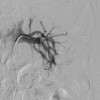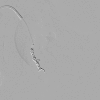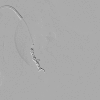Renal arteriovenous fistula after renal biopsy: a case report and literature review
- PMID: 31258554
- PMCID: PMC6582767
- DOI: 10.1590/1677-5449.011218
Renal arteriovenous fistula after renal biopsy: a case report and literature review
Abstract
Acquired renal arteriovenous fistulas (AVF) are rare conditions in which an anomalous connection arises between the arterial and venous systems. Renal AVFs can be classified into three main groups: idiopathic, congenital, and acquired, the last of which are the most common. Incidence has been increasing, due to the growing number of renal biopsies. Although the renal biopsy procedure is relatively safe nowadays, one possible complication is formation of an AVF in the renal vascular territory. Treatment of renal AVF is widely discussed in the literature and a variety of treatment methods can be employed. We report a case of arteriovenous fistula after renal biopsy that was successfully treated with endovascular coil embolization.
Resumo: Fístulas arteriovenosas (FAVs) renais adquiridas são raras, correspondendo a uma conexão anômala entre o sistema arterial e o sistema venoso. As FAVs renais se dividem em três grandes grupos: idiopáticas, congênitas e adquiridas, sendo as últimas as mais comuns. Atualmente, têm incidência aumentada em decorrência do crescente número de biópsias renais. Apesar de, atualmente, o procedimento de biópsia renal ser relativamente seguro, ele carrega como complicação a formação de FAV no território vascular renal. O tratamento de FAV renal é amplamente discutido na literatura e diversas modalidades terapêuticas podem ser aplicadas. Apresentamos um caso de FAV pós-biópsia renal que foi submetida a tratamento endovascular com sucesso mediante embolização com molas.
Keywords: arteriovenous fistula; coil embolization; needle biopsy; post-biopsy hematuria; renal Doppler; therapeutic embolization.
Conflict of interest statement
Conflicts of interest: No conflicts of interest declared concerning the publication of this article.
Figures






References
-
- Rezende LS, Ortiz MR, de Paula SC, Gemelli JJ, Linhares A, Carvalho JGR. Relato de caso: fístula arteriovenosa renal idiopática como causa de hipertensão renovascular e insuficiência cardíaca. J Bras Nefrol. 2002;24(2):110–114.
Publication types
LinkOut - more resources
Full Text Sources
